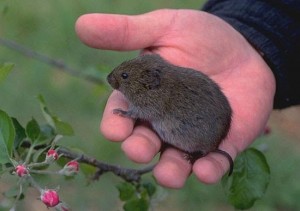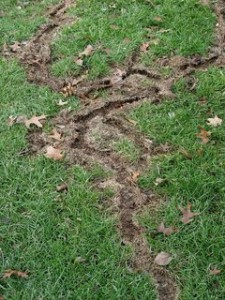Got Voles?
 How can something so cute and fluffy make such a mess in our lawns over the winter? If your lawn has little trails in it that look like the photo below, chances are there are voles in the lawn. A “vole” is basically a field mouse and they feed on plants and seeds in your lawn. They do most of their damage in our lawns during the winter when we have a good snow pack on the lawn. This is because their predators cannot see them hidden under the snow. With our unusual winter, we are seeing the damage earlier than normal this year.
How can something so cute and fluffy make such a mess in our lawns over the winter? If your lawn has little trails in it that look like the photo below, chances are there are voles in the lawn. A “vole” is basically a field mouse and they feed on plants and seeds in your lawn. They do most of their damage in our lawns during the winter when we have a good snow pack on the lawn. This is because their predators cannot see them hidden under the snow. With our unusual winter, we are seeing the damage earlier than normal this year.
The single best defense against voles is a neighborhood cat. Cats are great mousers and they do a great job of catching voles. Other predators include hawks, coyotes and garden snakes. Here are some important tips on what you should and should not do if you have vole damage:
DON’T RAKE THE GRASS…YET
If you rake the grass around the tunnels and trails, you may only do more damage to your lawn because your lawn is still mostly dormant. Please wait until after the lawn has been cut a few times before raking out all the dead grass.
SEED THE DAMAGED AREAS WITH RYE or WAIT TO SEED
Voles love seed….do not lure them back with more food. If you DO want to seed this Spring, use a quick germinating perennial rye and make sure to work it into the soil and protect the seed. Otherwise, let the predators thin out the population or let them go back into the woods or head for higher grass and wait to seed. You can also contact us for seeding help, but remember that Spring seeding can be difficult when using a pre-emergent to prevent crabgrass.
 EXTENSIVE DAMAGE
EXTENSIVE DAMAGE
If the damage is large (more than 20ft by 20ft) you have more than a couple of voles and you can set up some snap traps that you can find at local hardware stores. Bait the traps with peanut butter and oatmeal to lure the voles to them. Use caution though, if you have small children or outdoor pets around, you may not want to use snap traps in your lawn. Also, make sure to throw the traps away after a few weeks as they become unsafe when they start rusting. Other tactics to make the voles unwelcome in your lawn include destroying/disrupting the trails and nests, using vole baits (use extreme caution with this option due to danger with kids, pets and other animals), and vole repellents.
PROTECT YOUR TREES & SHRUBS
Voles also eat the bark & vascular tissue on trees & shrubs, “girdling” the trunk of the plants. If you see any damage to trees and shrubs, you can place some wire mesh around the base of the tree or shrub, digging it into the ground 3-4 inches.
If you are concerned about voles or have questions about anything we have said here, please do not hesitate to contact us here in the Lawn Doctor office at 630.406.8535.
